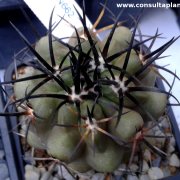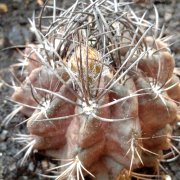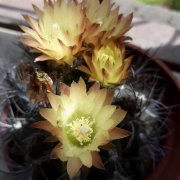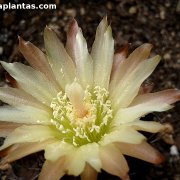Care of the cactus Copiapoa echinoides or Copiapoa dura |
|
The genus Copiapoa, family Cactaceae, comprises 25 species of cactus native to northern Chile. Some species are: Copiapoa echinoides, Copiapoa cinerea, Copiapoa calderana, Copiapoa grandiflora, Copiapoa malletiana, Copiapoa gigantea, Copiapoa humilis, Copiapoa coquimbana, Copiapoa taltalensis, Copiapoa krainziana, Copiapoa marginata. This species is native to Chile. Scientific synonyms: Copiapoa dura, Copiapoa cupreata. They are greyish-green or brown cacti with a globose body in their youth that can form colonies. These plants, which reach 18 cm (7")in diameter, have 11-17 ribs with pyramidal tubercles. They have 6-10 dark radial spines (up to 2.5 cm/0.98" in length) and 0-3 longer central black spines. The flowers are yellow with pinkish hues and appear at the apex. Copiapoa dura is used in pots and planters due to their small size; If they form groups, they are used in rockeries and gardens of cacti and succulents. Copiapoa echinoides needs direct sunlight exposure and good ventilation to avoid high humidity. The winter safety temperature is 4 ºC (39.2 ºF). Copiapoa cupreata prefers a soil composed of clay garden substrate, vermiculite, and coarse siliceous sand. A commercial cactus substrate with 20% coarse gravel can also be used. It is very important to let the soil dry completely before watering. It resists drought very well but are sensitive to excess moisture. Copiapoa dura does not require fertilizers or pruning. Copiapoa echinoides is very sensitive to excess watering that causes fungal diseases (fungi). Copiapoa cupreata propagates by separation of suckers or by seeds sown in spring but growth is slow. |
Images of the cactus Copiapoa echinoides or Copiapoa dura |
Find plants
Copiapoa echinoides or Copiapoa dura | Care and Growing
© 2026 FavThemes






